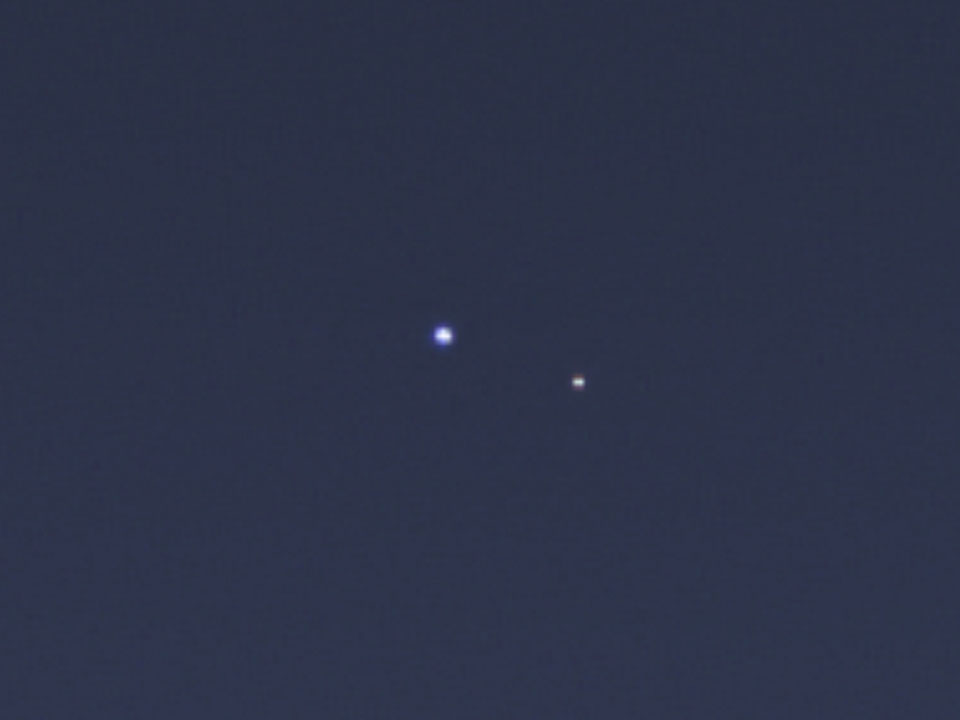Astronomy in Paradise Lost by Anna H. '14
I can't resist.
While I read Paradise Lost, I think about astronomy.
I know what you’re thinking: “what else is new?” You yawn and ask whether I salivate and breathe while reading Paradise Lost.
I know, I know! But read this description of our home planet in Book II and you’ll see what I mean:
“And fast by hanging in a golden chain
This pendent world in bigness as a star
Of smallest magnitude close by the moon.” (II.1051-3)
I’m not sure what Milton means by “magnitude.” In astronomy, we use the word “magnitude” to describe how bright an object is. Milton could definitely have known that technical term, because he spent a lot of time talking with Galileo. “Magnitude” here could also have meant “importance.” The term could be ambiguous by design, since Milton is fond of wordplay and double meaning. Regardless of his intention, when I read that passage I saw this in my mind:

That’s a photograph of our little blue “pendant world,” close by the moon and somewhere near the bigness of a star. There’s no golden chain to be seen, although I suppose you could think of the chain as a metaphor for our ecosystem’s fragility. The Cassini spacecraft snapped that picture last year and, although it’s only made up of two little fuzzy blobs, I personally think it’s one of the most beautiful pictures ever taken in astronomy.
Here’s another one (context: Satan is traveling to Heaven)
“Down right into the world’s first region throws
His flight precipitant and winds with ease
Through the pure marble air his oblique way
Amongst innumerable stars that shone–
Stars distant, but nigh hand seemed other worlds.” (III.563-6)
Spot on! In 1992, Alex Wolszczan and Dale Frail discovered the very first planets outside our solar system – “extrasolar planets”, or “exoplanets” – orbiting a pulsar. I’ve had interactions with both of these dudes: I attended a talk by Wolszczan about a year ago (at this conference) and I was visiting the National Radio Astronomy Observatory in Socorro NM when Dale Frail gave a teatime presentation about the discovery of FRBs (Fast Radio Bursts…very unfortunately nicknamed “furbies” by some astronomers). I borrowed a few papers from Dale, didn’t realize he needed them back that evening, took them with me on a field trip, then found out through a phone call that Dale really wanted his papers back since he was about to leave town. Mortified, I had to sprint across the VLA to hand the papers back to Dale, who happened to be on-site. AHHHH!
Anyway, the study of extrasolar planets is now one of the hottest sub-fields in astronomy. Professors Sara Seager and Josh Winn are spearheading efforts at MIT, and TESS is going to revolutionize our big-picture of these other worlds. Recently, a study predicted that 20% of all sun-like stars in our galaxy have an Earth-sized planet in the habitable zone (the “goldilocks zone” – not too close to the star and hot, not too far away and cold). “Is in the habitable zone” is a very different thing from “habitable,” and “habitable” is a very different thing from “inhabited,” but it’s still very exciting stuff.
There are many more instances in Paradise Lost of Milton’s astronomy interest (including the phrase “glazed optic tube” for “telescope”) but I’ll finish off with a discussion of light.
Ultimately, astronomy is about collecting light. Our eyes are pretty good detectors, so for many centuries astronomers relied on them. For example, when Galileo stuck his eye at the end of a telescope, photons from Europa, Ganymede, Callisto, and Io entered his eye after traveling ~800,000 kilometers across the solar system – and voila! Galileo literally saw the moons of Jupiter. Nowadays, we can do much better than human sight by building increasingly advanced cameras. We can even “see” invisible light, by building detectors designed to make sense of radio light, x-ray light, infrared light, etc.
When John Milton wrote PL, he was completely blind. Presumably because of that, the blind narrator of PL (who I’m not convinced is Milton himself) takes detours from storytelling to discuss the nature of light and sight, and I think it’s totally fascinating that he chooses to discuss astronomy and telescopes at all.
One major idea presented is that light has an eternal-physical duality: the essence of light is eternal, and it is a manifestation of that essence that we see as a shining beam. Nowadays, of course, we would say that light has wave-particle duality, and that in a way a particle we detect is a manifestation of the wave, but Milton hadn’t taken 8.04 so it would have been kind of unreasonable to expect that from him.
I think that the blind Milton found comfort in the idea that we don’t need eyes to detect the essence of light, and that even the best telescopes can’t protect us from every kind of shroud. For example, a good liar can deceive even the sharpest detectors. In Book III, God’s right-hand sharp-sighted angel Uriel is deceived by Satan in disguise, and the result of this deceit is that Uriel gives Satan directions to the Garden of Eden. This inspires the blind Milton narrator to pray to light for a deeper kind of sight, in my favorite passage of the book so far:
“…celestial Light,
Shine inward and the mind through all her powers
Irradiate. There plant eyes. All mist from thence
Purge and disperse, that I may see and tell
Of things invisible to mortal sight!” (III.51-5)